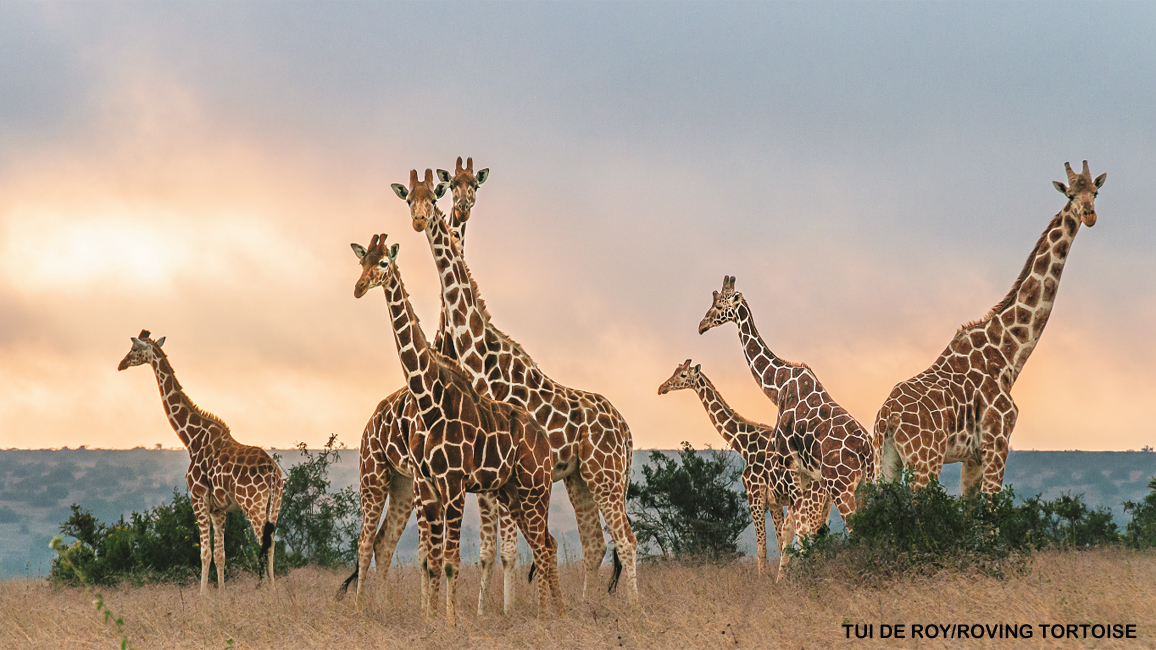
Don’t Laugh at the Giraffe
By Anne CisselDo you think a giraffe looks silly with its long neck, big ears, and patchy coat? It turns out each of its wacky body parts has a SERIOUS job to do.

When scientists first saw a giraffe, they were very confused by the way it looked. That’s why they gave it the scientific name Giraffa camelopardalis, which means “fast-walking camel-leopard.” It’s not related to either of those animals!
But scientists got the “fast-walking” part right. To keep up with a walking giraffe, you would need to run as fast as you could. And if it started to run—forget it! You would be left in the dust. With its six-foot-long legs, it can run up to 35 miles per hour. Running fast helps the giraffe escape from a lion or other enemy.
Its speed is just one of the giraffe’s special adaptations. Adaptations are ways an animal’s body or actions help it survive in the place where it lives. Keep reading to explore how a giraffe keeps itself safe, well fed—even clean!

ALL-DAY EATERS
Africa is the only place you can find giraffes in the wild. They roam on tree-dotted plains called savannas. Tree leaves, flowers, seeds, and fruits are on the menu for these giant mammals. Each giraffe can eat up to 75 pounds of the stuff in a day! Luckily, a giraffe has lots of tricks to keep its tummy full. The giraffe is the tallest land animal on Earth. It can reach leaves in trees that other animals cannot. And its long, bluish tongue and upper lip are prehensile (pree-HEN-suhl). They work together, the way hands do, grasping and pulling leaves off trees.
The giraffe is a ruminant (ROO-muh-nunt). A ruminant’s stomach can’t completely break down the food the first time it arrives. So a giraffe eats twice! First, it chews the leaves and swallows them. After a while, it coughs up the food, now called cud, and chews it again.
All this chewing and eating takes a lot of time—16 to 20 hours each day. Luckily, a giraffe needs to sleep only a few hours every day. It doesn’t need to drink very often, either. It gets most of its water from the food it eats. That’s good, because bending down to sip water is not easy.
EXTRAORDINARY NECKS
A giraffe actually has the same number of neck bones as a person does: only seven! But each of our neck bones is less than half an inch long. A giraffe neck bone is more than 10 inches long! The neck bones of a giraffe are connected to each other in a special way that lets the neck bend in every direction. This makes it easier to snag hard-to-reach leaves from trees.

BATTLE TIME
Most of the time, giraffes are peaceful animals. But male giraffes, or bulls, will sometimes fight to decide who’s boss. These battles are called “necking” because the giraffes use their necks as weapons. Lots of times, bulls simply wrap their necks together, pushing each other. But other times, they spread their front legs and swing their necks like clubs to smack each other. Usually, bulls don’t get badly hurt during these tussles.
EARS, COAT, AND HEART
Besides having an awesome neck, a giraffe has many other interesting body parts that help it survive. Those big ears are like satellite dishes, picking up sounds that could signal danger. And its patchy coat helps it blend in with the patches of light and shade of the African savanna.
Another amazing part of a giraffe is its heart, the strongest heart in the animal kingdom. It’s bigger than your head and weighs about as much as a two-year-old child. An adult human heart pumps about a gallon and a half of blood every minute. A giraffe’s heart pumps up to 10 gallons of blood every minute. That’s what it takes to push blood all the way up that neck to the giraffe’s brain!

BIG BABIES
When a baby giraffe, or calf, is born, it is already taller than many adult humans. The mother gives birth standing up, so the calf starts life by dropping about five feet to the ground. The fall doesn’t hurt it, though. Within an hour after birth, it’s able to walk!
During its first week, the calf grows more than an inch a day. At one year, it will be almost 12 feet tall. It needs to grow quickly. Lions and other predators are lurking nearby.
A calf will stay with its mother for more than a year after birth. Sometimes, in order for the mother to eat, she will leave her calf with another female and other calves. This group is called a crêche (KRESH), but it’s also called a “giraffe kindergarten.” Having babysitters is another trick that helps giraffes survive!
KEEPING GIRAFFES SAFE
Even with all their cool adaptations, there aren’t as many giraffes as there used to be. Their habitat has been taken over by farms and towns. And people still hunt giraffes in the wild, even though it is illegal in most countries. Lucky for the giraffes, national parks give them safe spaces to roam. And people are working to set aside even more land for giraffes. More protections mean more giraffes, and that’s something we can ALL cheer for!
Test your giraffe knowledge. Play Kahoot!

















